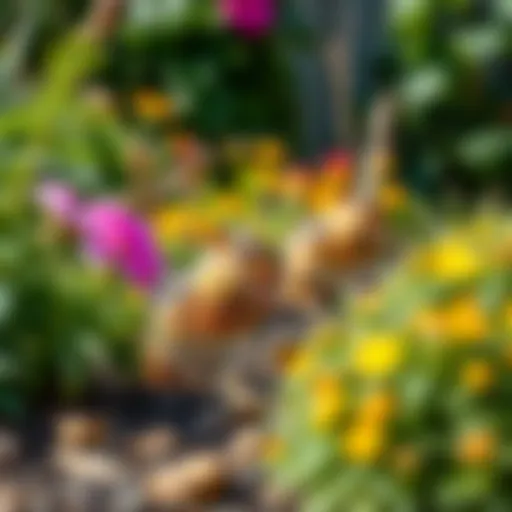Identifying Carpenter Bees: Signs and Insights
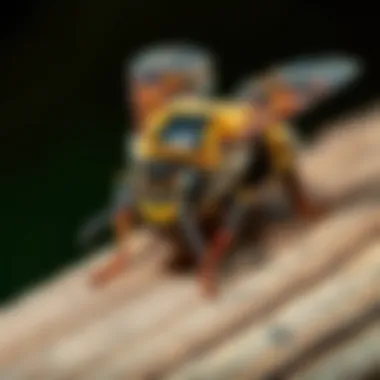
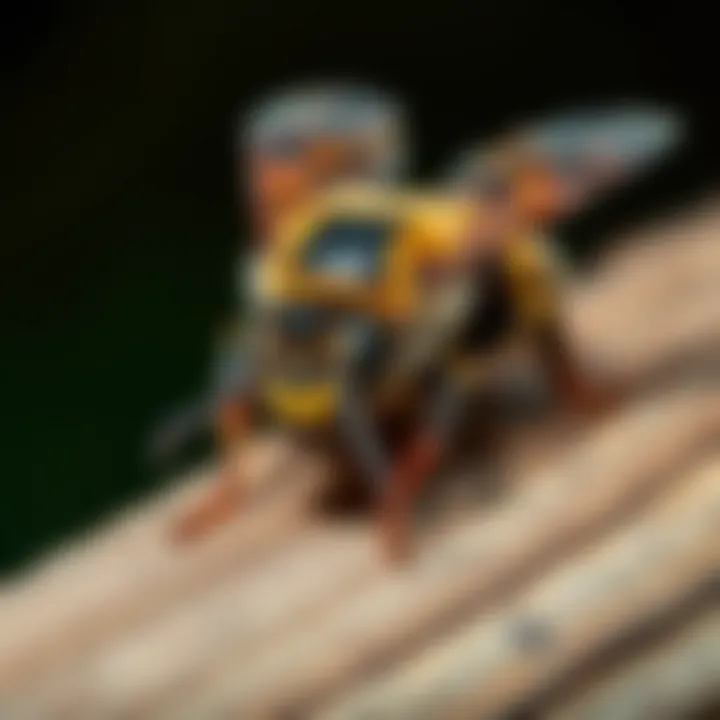
Intro
Carpenter bees, despite their often misunderstood nature, play a pivotal role in our ecosystems. These insects are not just unwelcome guests; they are vital pollinators. However, when they decide to make a home out of your wooden structures, the charm begins to wear off quickly. Understanding these fascinating creatures starts with knowing how to identify them, their behaviors, and the damage they can do. This guide aims to shed light on their distinct characteristics and provide you with the essential knowledge to handle any potential infestations effectively.
Understanding Pests
Definition of Pests
Pests, by nature, are organisms that interfere with our activities, health, or environment. They can be insects, rodents, or fungi, among others. Carpenter bees fit snugly into this definition as they pose threats when they invade our homes and landscapes. What sets them apart is the duality of their existence—they are both beneficial pollinators and damaging pests, depending on the context of their presence.
Importance of Pest Identification
Identifying pests like carpenter bees is crucial for effective home management. Knowing what you are dealing with helps to inform your action plan. Most importantly, not all insects that buzz around your garden need to be exiled. Carpenter bees, for example, do more than bore holes into wood; they assist in plant reproduction. Hence, recognizing their behaviors and signs allows you to strike a balance between maintaining a healthy garden while safeguarding your property.
Signs of Carpenter Bees
Identifying carpenter bees involves observing their behavior and looking for specific indicators.
- Appearance: These bees are often confused with bumblebees but lack the yellow bands. Instead, they exhibit a shiny, black abdomen.
- Behavior: Carpenter bees are solitary creatures, preferring to live independently rather than within colonies. They exhibit a distinct flying pattern, often hovering around wooden structures.
- Damage: Look for round holes, about a half-inch in diameter, that lead into wooden surfaces. The presence of sawdust or wood fillings beneath these holes is a significant sign.
"Carpenter bees can cause substantial damage to wooden structures, especially when their presence goes unnoticed for a long period."
Prevention Techniques
Home and Garden Preventative Measures
Implementing preventive measures around your property can keep carpenter bees at bay. Consider the following strategies:
- Sealing Wood: Applying paint or stain on wooden surfaces can deter carpenter bees from burrowing into them, making the wood less appealing.
- Material Choice: Using harder woods such as cedar or redwood in deck and fence construction can provide resistance against these pests.
- Landscaping Practices: Keep floral plants outside your home that can attract pollinators away from your wood.
Seasonal Prevention Tips
You can also adopt seasonal strategies to further minimize risks:
- Spring Check: As temperatures rise, inspect your home for signs of carpenter bee activity before they mate.
- Early Intervention: If you find holes, it is best to treat them immediately with appropriate insecticides or sealants to prevent colonies from establishing.
- Regular Maintenance: Maintain your garden regularly by trimming overgrown plants that may attract these bees.
Eco-Friendly Pest Control Solutions
Overview of Sustainable Practices
When dealing with pests like carpenter bees, it's imperative to choose eco-friendly solutions. Chemical treatments can harm beneficial insects, including the bees you want to encourage. A few sustainable practices include:
- Traps: Set up traps near problem areas to capture bees without killing them.
- Natural Repellents: Utilise essential oils that deter carpenter bees, such as citrus or tea tree oil, sprayed around wooden structures.
Natural Remedies and Their Effectiveness
Many natural remedies can effectively discourage carpenter bees:
- Vinegar Spray: A solution of water and vinegar can deter bees when applied directly to wooden surfaces.
- Cinnamon: This spice has properties that can repel various insects, including carpenter bees.
Recognizing carpenter bees through their distinctive signs and behaviors is essential for maintaining a healthy home and garden. Utilizing effective prevention techniques ensures both ecological health and sustainable pest management in your living spaces. To learn more about bee identification and pest management strategies, you can visit Wikipedia or check resources on USDA.
Prolusion to Carpenter Bees
Carpenter bees might not strike you as the cuddly type in the insect world, but their presence in our backyards is certainly noteworthy. Many homeowners overlook these buzzing fellows, considering them nothing more than a nuisance. Yet, understanding carpenter bees is indeed a crucial step to safeguard your wooden structures and foster a healthier ecosystem.
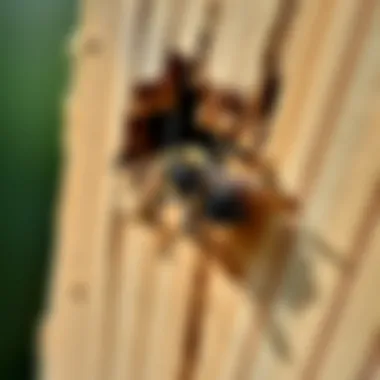
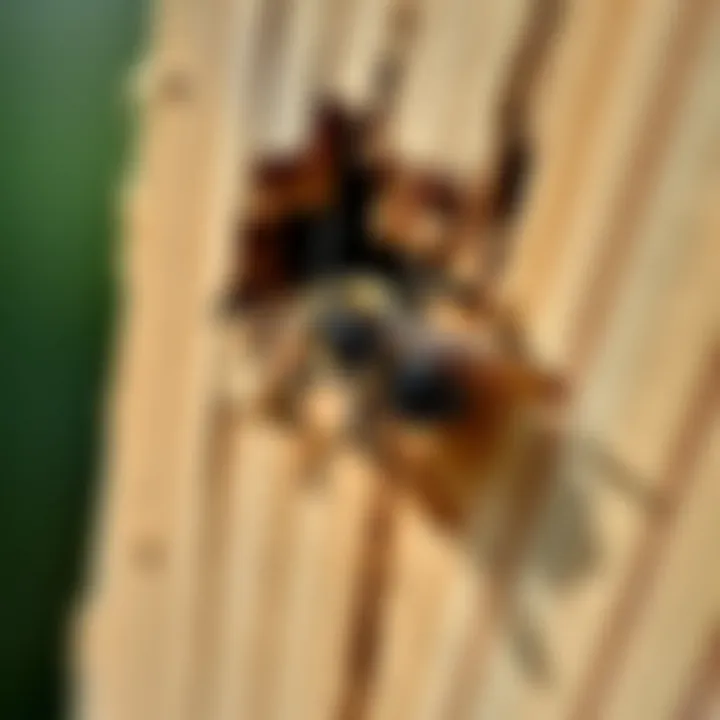
The relevance of discussing carpenter bees lies in their dual role as both pollinators and potential pests. They are often mistaken for bumblebees; however, their habits and impacts set them apart. Spotting these bees early can save you from extensive damage to your decks, eaves, and fences, making identification a key part of home maintenance.
Understanding Carpenter Bee Behavior
Carpenter bees exhibit fascinating behavior patterns. Unlike honeybees or wasps, they prefer to be solitary. Males can be seen zipping around with a bit more bravado, often trying to defend their territory. They might get confrontational, but it’s important to note that they do not possess stingers. Males may approach boldly, buzzing right in your face, but unless provoked, they won't harm you.
Females, on the other hand, take a more subdued approach. Their main task is to drill into wood to build nests. This excavation is a key behavior to observe when you suspect carpenter bee activity. The female goes through the wood like a hot knife through butter, leaving distinct signs that any vigilant homeowner should be aware of. Drilling is primarily carried out in the warmer months, so if you hear that rhythmic tapping sound, it’s time to pay attention.
Importance in the Ecosystem
Beyond their sometimes troublesome tendencies, carpenter bees play a pivotal role in maintaining ecological balance. They are essential pollinators, often visiting a range of blooming plants. This service significantly contributes to the health of local flora and the wider environment.
"Pollinators are key to biodiversity; without them, many plants would struggle to reproduce."
Through cross-pollination, these bees help facilitate the growth of fruits, vegetables, and various flowers. A yard buzzing with carpenter bees can be a sign that your garden is thriving. By attracting these creatures, you contribute to a better ecosystem, promoting healthy plants for both your enjoyment and that of surrounding wildlife.
Thus, while monitoring their activities might feel tedious, there's a silver lining. Implementing proper pest management techniques can ensure that you maintain a healthy rapport with these pollinators while protecting your beloved wooden structures.
Physical Characteristics of Carpenter Bees
Understanding the physical features of carpenter bees is crucial for accurate identification and assessment of their potential impact on your property. Their appearance offers significant insights into their habits and behavior, and recognizing these traits can aid homeowners in taking appropriate measures for control and prevention.
Carpenter bees, generally solitary insects, are often mistaken for bumblebees due to their similar size and coloration. However, focusing on their specific physical characteristics allows one to differentiate between them effectively.
Distinguishing Features
Carpenter bees possess several distinguishing features that set them apart from other bee species. Some key characteristics include:
- Body Shape: Carpenter bees are characterized by a robust, cylindrical body which is typically shiny and black. Unlike bumblebees, their abdomen is mostly hairless and smooth, giving them a distinct shiny appearance that is easy to spot.
- Size: On average, these bees range from 1/2 inch to 1 inch in length, with females being larger than males.
- Coloration: Females are generally all black, while males often display a bright yellow or white coloration on their faces, adding to the visual contrast between sexes.
- Wing Structure: When at rest, the wings of a carpenter bee lie flat along their body, which is a feature that can be used to quickly identify them when perched.
These physical traits are important not only for identification but also for understanding their role within the ecosystem.
Male vs. Female Identification
Identifying whether a carpenter bee is male or female is crucial for understanding their behavior and role in reproduction. Key differences to note include:
- Facial Markings: As mentioned earlier, male carpenter bees often have distinct yellow or white markings on their face, while females lack these markings. This can be your first clue when observing them.
- Behavioral Traits: Males are more likely to display territorial behavior, often seen hovering near nesting sites, while females tend to be more focused on nesting and reproduction.
- Nesting Responsibilities: Only female carpenter bees are responsible for nesting, as males do not partake in building or caring for the nest. This understanding can help homeowners address infestations more strategically.
By familiarizing yourself with these physical characteristics and gender distinctions, you become better equipped to recognize and address carpenter bee presence in your surroundings.
"Carpenter bees are often the quiet invaders of homes, silently drilling into wooden structures, making awareness of their characteristics paramount for effective management."
For further reading on bee identification, consider visiting Britannica or exploring Wikipedia for comprehensive details and illustrations.
Understanding these bees not only aids in management efforts but also enhances one's appreciation of their role in the environment.
Common Signs of Carpenter Bee Presence
Carpenter bees can easily blend into their surroundings, making their presence tricky to identify. Understanding the signs of these insects is essential for homeowners who want to prevent potential damage. Identifying these cues is not just about noticing a bee now and then; it’s about understanding their habits and the areas they like to inhabit.
Noticing holes on your property or finding sawdust can indicate unwanted guests have made themselves at home. Acting swiftly can save the structural integrity of your residence. Homeowners must familiarize themselves with these signs to avoid costly repairs later.
Visible Drilling Holes
When you see holes in your wooden structures, it’s hard to overlook their significance. Carpenter bees drill circular holes to create nests, and their handiwork is often the first indication of their presence.
Size and Shape of Holes
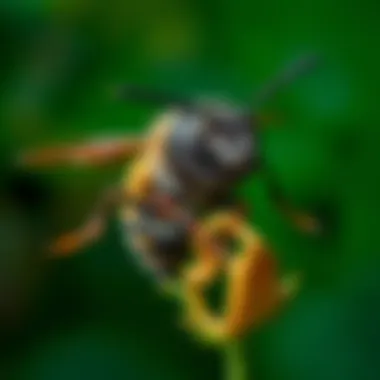
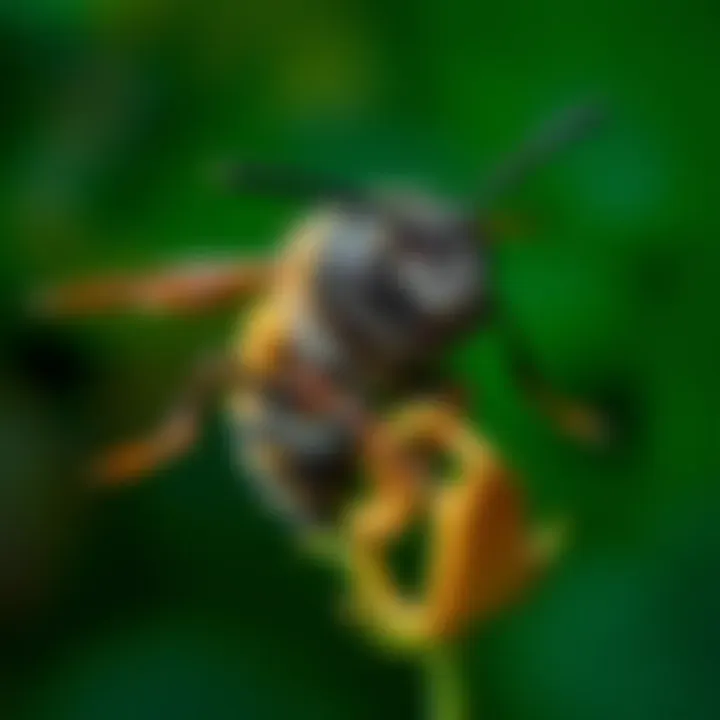
The holes created by carpenter bees are typically about half an inch in diameter and perfectly round. This characteristic makes them quite distinct from other pests, as many insects leave irregular or various-sized openings. The neatness of these holes is a key identifier. Homeowners may often mistaken these for other types of damage, but once you know their exact shape, it’s easier to address the issue. Identifying these features can help in formulating a targeted response, given their unique stature.
Location of Damage
Location matters when it comes to identifying the presence of carpenter bees. These insects prefer to nest in untreated wood, often targeting eaves, fence posts, or even wooden furniture exposed to outdoor elements. High visibility might indicate habitual nesting, while hidden areas can mask significant issues over time. Knowing where to look is just as important as recognizing the holes themselves.
Sawdust Accumulation
Finding sawdust is almost like spotting a breadcrumb trail leading us to the source of the problem. Carpenter bees chew through wood, and the resulting sawdust typically accumulates near their drilling holes, often falling on the ground or clinging to the surface of the wood.
Types of Surfaces Affected
Softwoods, especially those that are untreated, are often the main target. This could be your porch, deck, or even wooden toys left outside. The damage can be quite significant because, once these areas are infested, the bees may continue gnawing away, compromising the structural soundness.
Visual Indicators of Infestation
If you come across sawdust piles, it’s a telltale sign of carpenter bees at work. Within the sawdust, look for scaly particles that seem more fluffy compared to traditional wood shavings. This finer texture signals ongoing activity. The presence of both holes and sawdust indicates that you have a problem that needs to be addressed quickly.
Bee Activity Observance
Observing the behavior of bees can provide valuable clues about what’s happening in your yard. Their flights and activities can reveal nesting sites and help assess the severity of the infestation.
Flight Patterns and Behavior
Carpenter bees usually exhibit a rather erratic flight pattern, often hovering around the nest or darting to and from flowers. They can be mistaken for bumblebees because of their similar appearance, but their actions can help differentiate them. Their interest in certain areas can point you toward locations that need inspecting.
Time of Day for Activity
Carpenter bees are most active during warm, sunny days, especially in late morning to early afternoon. Watching for their activity during these times will increase your chances of identifying and preventing further infestations. If you see bees consistently during these hours, it could be time to investigate further.
"Understanding the signs of carpenter bee presence can save you time, effort, and money in the long run."
Monitoring these indicators not only enhances the knowledge a homeowner has about their property but can also guide effective control measures. Ignoring these signs could lead to severe structural damage that may not be easy or cheap to fix.
By being proactive and recognizing these common signs, you can maintain the integrity of your dwelling and reduce the risk posed by carpenter bees.
Potential Damage Caused by Carpenter Bees
Understanding the potential damage caused by carpenter bees is essential for homeowners. While these creatures may not exhibit the same aggressive behavior as other pests, their nesting habits can lead to significant problems. Carpenter bees primarily bore into wood as a means of creating nest sites for their young, which places them in direct conflict with human structures, particularly those made of untreated wood. The implications of their presence extend beyond mere annoyance; if left unchecked, they can compromise the structural integrity of homes and other wooden edifices.
The alarming truth is that carpenter bees can weaken timbers and frameworks over time.
"A stitch in time saves nine."
Structural Concerns
The structural concerns posed by carpenter bees are not to be taken lightly. These bees tend to favor untreated wood, particularly in warm, sunny locations.
- Wood Siding: When they select your wooden siding for their cozy nest, tiny holes may become entry points that further invite water infiltration and decay.
- Decking: If your deck has exposed beams, it might become a banquet hall for these insects, leading gradually to weakening wood that could compromise safety.
- Eaves and Rafters: Carpenter bees often target the eaves of dwellings, creating nests that, while not immediately visible, can erode structural supports over time.
Homeowners must keep an eye out for these signs. Early identification can save a lot of trouble down the road.
Impacts on Wooden Structures
The impacts on wooden structures caused by carpenter bees can be both immediate and long-term. When they bore through wood, they create perfectly round holes. These holes not only signal an active infestation but can also lead to:
- Moisture Retention: Wood bore holes can expose the inner fibers of the wood, making them prone to water damage. This can accelerate rot and mold growth.
- Pest Invitation: Once the wood is damaged, other pests may move in, further aggravating an already risky situation for your home.
- Aesthetic Decline: Visible holes can mar the beauty of wooden structures, leading to a drop in property value.
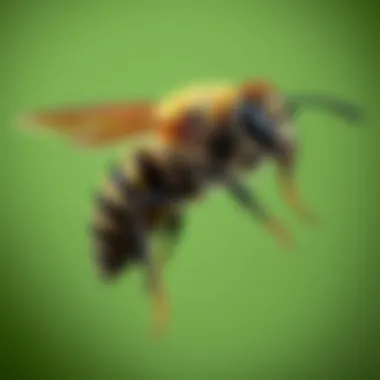
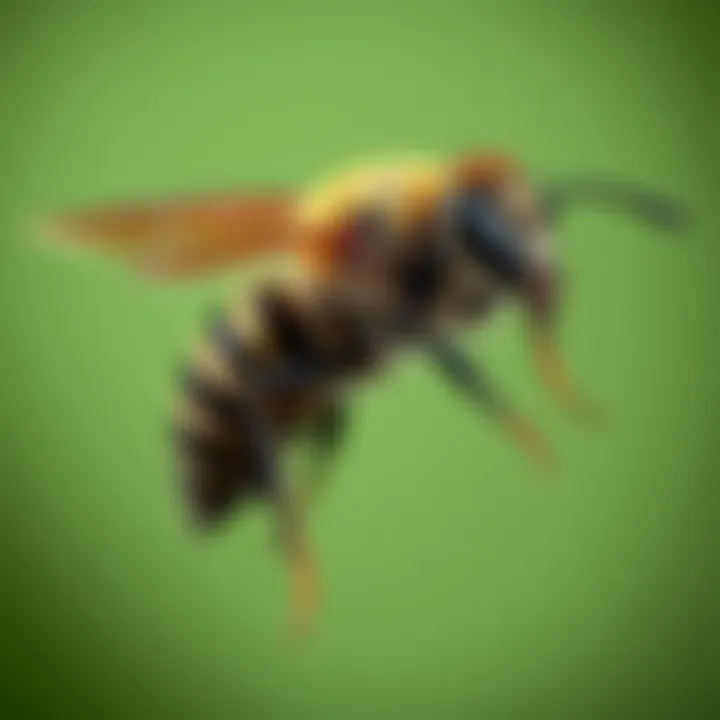
To mitigate the risk, timely action is essential. Regular inspection of wooden areas combined with appropriate preventive measures—such as painting or treating wood surfaces—can help protect your home from the consequences of carpenter bee activity.
By addressing these structural concerns and potential impacts proactively, homeowners can significantly reduce risks and maintain a sturdy yet inviting environment in their homes.
Methods of Control and Prevention
Understanding how to control and prevent carpenter bees from taking up residence in your home or garden plays a pivotal role in safeguarding your property. The damage they can cause is not just cosmetic; it can lead to significant structural problems if left unchecked. This section aims to arm you with actionable techniques to monitor their activity, block their access, and implement eco-friendly solutions. Each method emphasizes proactive strategies that can minimize the likelihood of infestations.
Inspection and Monitoring Techniques
Regular inspection is your first line of defense against carpenter bees. Knowing what to look for is crucial in identifying their presence before they do extensive damage.
- Visual Checks: Periodically inspect wooden structures around your home. Look for round holes roughly 1/2 inch in diameter, which are characteristic of carpenter bee nests.
- Sound Monitoring: Listen closely to your surroundings. The distinctive sound of drilling can indicate bee activity. On calm days, this subtle noise is an essential cue not to overlook.
- Marking Infested Areas: If you find signs of drilling, mark the area with tape or a small dot. This aids in tracking if there’s an increased activity in certain spots over time.
Physical Barriers and Exclusions
Preventing carpenter bees from accessing your property begins with physical barriers. These simple measures can be very effective in deterring them from nesting.
- Seal Cracks and Gaps: Inspect your home for any existing cracks in wooden structures, railings, decks, or fences. Use exterior-grade caulk or wood putty to fill these openings.
- Protective Coatings: Apply paint or varnish to exposed wood surfaces. Carpenter bees are less likely to nest in treated surfaces than in untreated wood.
- Install Screens: Covers for vents or openings can also serve as barriers, making it difficult for bees to enter.
Eco-Friendly Control Options
Using eco-friendly solutions reflects an understanding of harming the bees' ecosystem. Hence, finding a balance is key.
Nesting Habits Disruption
Disrupting the nesting habits of carpenter bees can significantly reduce their presence. This approach focuses on interfering with their natural behavior before nests become established.
- Timing of Interventions: Targeting the nests during the early spring when the bees are just emerging can be most effective. Use a stiff brush or vacuum to remove any visible nests before they become active.
- What’s Great About This Method: This method not only prevents new nests but avoids pesticides, keeping the ecosystem intact. However, it requires consistency, so monitoring must be done regularly during the season.
Planting Strategies to Deter
Incorporating specific plants can naturally deter carpenter bees, contributing to a more vibrant landscape.
- Choose Resilient Flora: Select plants like mint, and rosemary, which have scent profiles that discourage bee habitation. The aromatic oils in these plants are often off-putting to these pollinators.
- Landscape Layout: Position these plants strategically around wooden structures or decks. Doing so forms a natural barrier that may deter them from approaching your woodwork.
- Benefits of this Strategy: Using plants not only helps in controlling bee populations but also enhances biodiversity. This method enriches your garden without chemical interventions, although it can require careful planning to ensure desired effects.
Remember, proactive management of carpenter bees involves a responsive approach to monitoring, physical prevention methods, and employing environmentally friendly strategies. Each action contributes to a more resilient living environment.
Epilogue
Identifying carpenter bees and understanding their behavior is vital for homeowners and anyone interested in pest control. These bees play a pivotal role in our ecosystem, yet they can also pose threats to wooden structures. Recognizing the signs of their presence not only helps mitigate potential damage, but it also encourages respectful coexistence with nature.
Recap of Carpenter Bee Identification
To efficiently manage carpenter bees, one must first become familiar with their key identifying features. These insects have a distinct appearance, with males presenting a yellow face and females equipped with a shiny black abdomen. Spotting visible drilling holes—often a round quarter-inch in diameter—along wooden surfaces serves as a primary indicator of their activity.
It's also crucial to pay attention to other signs, such as
- Sawdust accumulation, which is typically found near these holes,
- Bee activity, including flight patterns that often happen during warmer parts of the day.
Being aware of these indicators empowers individuals to act promptly, setting the foundation for effective management strategies.
Final Thoughts on Sustainable Management
When it comes to controlling carpenter bees, adopting sustainable practices is imperative. Rather than resorting to harsh chemicals, consider implementing eco-friendly solutions. This includes installing physical barriers or using natural repellents that can help deter these bees without causing them harm.
Moreover, planting certain flowers can keep carpenter bees at bay, offering an optimal balance between pest control and ecological integrity. Effective management lies not in eradication but in fostering a comprehensive understanding of these bees and how to coexist with them.
By equipping yourself with knowledge and practical strategies, you can safeguard your home while also preserving a vital part of our ecosystem. These efforts cultivate an environment where both human and insect life can thrive.
"Understanding the role of carpenter bees can transform the way we manage our spaces, benefiting both our homes and the environment."
For further reading, one might consider perusing resources such as Wikipedia or Britannica for deeper insights.



